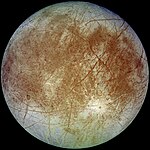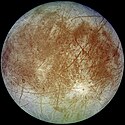Galileiske måner
 Der er for få eller ingen kildehenvisninger i denne artikel, hvilket er et problem. Du kan hjælpe ved at angive troværdige kilder til de påstande, som fremføres i artiklen.
Der er for få eller ingen kildehenvisninger i denne artikel, hvilket er et problem. Du kan hjælpe ved at angive troværdige kilder til de påstande, som fremføres i artiklen.
De galileiske måner er fire af planeten Jupiters måner, nemlig Io, Europa, Ganymedes og Callisto. De blev alle opdaget af astronomen, fysikeren og filosoffen Galileo Galilei, da han i januar 1610 som en af de første brugte den dengang helt nye opfindelse kikkerten til astronomiske observationer. Io, Europa og Callisto blev opdaget den 7. januar, og mens han de efterfølgende nætter studerede de tre små "drabanter" til Jupiter, dukkede den fjerde, Ganymedes, op den 11. januar.
Alle fire måner har navne efter Zeus' elskere i den græske mytologi; navne der blev foreslået af Simon Marius kort tid efter opdagelsen. Men Galilei nægtede at bruge Marius' navneforslag, og indførte i stedet et nummereringssystem med romertal: Den måne vi i dag kender som Io fik betegnelsen "Jupiter-I", Europa kom til at hedde "Jupiter-II", Ganymedes "Jupiter-III" og Callisto "Jupiter-IV". Først i midten af det 20. århundrede vandt navnene fra den græske mytologi udbredelse, men Galileis nummersystem bruges stadigvæk parallelt med navnene. Når man opdager en ny Jupitermåne, får den pr. automatik et nummer efter Galileis system, og numrene har det med at "hænge ved" månerne, også efter at den Internationale Astronomiske Union har vedtaget egentlige navne til dem.
Kæmpemåner der ligner Jorden
De fire galileiske måner hører til nogle af de største i Solsystemet — rekorden indehaves af Ganymedes med en diameter på 5 262 kilometer — større end planeten Merkur. Under optimale observationsforhold er det endda muligt at se Callisto, den yderste af de fire måner, med det blotte øje, og der er teorier fremme om, at månerne måske har været kendt siden oldtiden.
Samtidig skiller de galileiske måner sig ud fra flertallet af Solsystemets måner ved at være kompakte legemer af jern og sten med stor massefylde. Med undtagelse af Io findes der masser af vand, om end det i vid udstrækning er i form af fast is. På Europa og Ganymedes, som begge bevæger sig rundt i det intense strålingsbælte omkring Jupiter der svarer til Jordens Van Allen-bælter, findes der en uhyre tynd atmosfære af rent ilt: Strålingen sønderdeler vandmolekyler fra månernes is-overflader, og brinten undslipper på grund af sin lave molekylevægt meget nemt månernes begrænsede tyngdekraft, mens ilten bliver tilbage.
Ganymedes har endda sin egen pladetektonik, der ligesom på Jorden forandrer terrænet på Jupitermånens overflade. Men mens kontinenterne og "pladerne" her på Jorden består af klipper der flyder på magma, består Ganymedes' plader af is, og dens "magma" er efter alt at dømme flydende vand.
Fysiske data
Alle fire galileiske måner har bunden rotation på grund af den relativt korte afstand til Jupiter og dens tyngdekraft: De drejer én gang rundt om sig selv på præcis den tid det tager dem at fuldføre et kredsløb om Jupiter, dvs. de vender altid den samme side mod Jupiter.
Jupiter er temmelig "fladtrykt" på grund af dens hurtige rotation om sig selv, og den "udbulning" det giver den langs ækvator, udøver et træk i de nærmeste måner og søger at tvinge deres kredsløb ind i Jupiters ækvatorplan — som det ses af tabellen herunder, ligger alle fire galileiske måners baneplan indenfor en halv grad fra ækvatorplanet.
En anden interessant detaljer ved Io, Europa og Ganymedes, er den baneresonans der består mellem de tre måners omløbstid: På den tid Io fuldfører fire omløb, fuldfører Europa to omløb og Ganymedes ét. Dette forhold medvirker til de stærke tidevandskræfter der leverer energi til Ios vulkaner og får Europas overflade til at slå revner.
| Io Jupiter-I | Europa Jupiter-II | Ganymedes Jupiter-III | Callisto Jupiter-IV | |
 |  |  |  | |
| Middelafstand til Jupiter: | 421 700 km | 671 034 km | 1 070 412 km | 1 882 709 km |
| Siderisk omløbstid, = rotationstid | 1d 18t 27m 33,5s | 3d 13t 13m 42,042s | 7d 3t 42m 33,376s | 16d 16t 32m 11,19s |
| Baneexcentricitet: | 0,0041 | 0,0094 | 0,0011 | 0,0074 |
| Banehældning: | 2,21° i fh. t. ekliptika 0,05° i fh. t. Jupiters ækv. | 1,79° i fh. t. ekliptika 0,47° i fh. t. Jupiters ækv. | 2,21° i fh. t. ekliptika 0,20° i fh. t. Jupiters ækv. | 2,02° i fh. t. ekliptika 0,21° i fh. t. Jupiters ækv. |
| Diameter: | 3631 – 3660 km | 3122 km | 5262 km | 4821 km |
| Masse: | 8,9319·1022 kg | 4,800·1022 kg | 1,4819·1023 kg | 1,0759·1023 kg |
| Massefylde: | 3528 kg/m³ | 3014 kg/m³ | 1942 kg/m³ | 1834 kg/m³ |
| Tyngdeacceleration ved ækvator: | 1,79 m/s² | 1,31 m/s² | 1,43 m/s² | 1,24 m/s² |
| Albedo: | 63 % | 67 % | 43 % | 17 % |
Eksterne henvisninger
| ||||||||||||||||||||||||||||||
|
Medier brugt på denne side
Original Caption Released with Image:
NASA's Galileo spacecraft acquired its highest resolution images of Jupiter's moon Io on 3 July 1999 during its closest pass to Io since orbit insertion in late 1995. This color mosaic uses the near-infrared, green and violet filters (slightly more than the visible range) of the spacecraft's camera and approximates what the human eye would see. Most of Io's surface has pastel colors, punctuated by black, brown, green, orange, and red units near the active volcanic centers. A false color version of the mosaic has been created to enhance the contrast of the color variations.
The improved resolution reveals small-scale color units which had not been recognized previously and which suggest that the lavas and sulfurous deposits are composed of complex mixtures (Cutout A of false color image). Some of the bright (whitish), high-latitude (near the top and bottom) deposits have an ethereal quality like a transparent covering of frost (Cutout B of false color image). Bright red areas were seen previously only as diffuse deposits. However, they are now seen to exist as both diffuse deposits and sharp linear features like fissures (Cutout C of false color image). Some volcanic centers have bright and colorful flows, perhaps due to flows of sulfur rather than silicate lava (Cutout D of false color image). In this region bright, white material can also be seen to emanate from linear rifts and cliffs.
Comparison of this image to previous Galileo images reveals many changes due to the ongoing volcanic activity.
Galileo will make two close passes of Io beginning in October of this year. Most of the high-resolution targets for these flybys are seen on the hemisphere shown here.
North is to the top of the picture and the sun illuminates the surface from almost directly behind the spacecraft. This illumination geometry is good for imaging color variations, but poor for imaging topographic shading. However, some topographic shading can be seen here due to the combination of relatively high resolution (1.3 kilometers or 0.8 miles per picture element) and the rugged topography over parts of Io. The image is centered at 0.3 degrees north latitude and 137.5 degrees west longitude. The resolution is 1.3 kilometers (0.8 miles) per picture element. The images were taken on 3 July 1999 at a range of about 130,000 kilometers (81,000 miles) by the Solid State Imaging (SSI) system on NASA's Galileo spacecraft during its twenty-first orbit.
The Jet Propulsion Laboratory, Pasadena, CA manages the Galileo mission for NASA's Office of Space Science, Washington, DC.
This image and other images and data received from Galileo are posted on the World Wide Web, on the Galileo mission home page at URL http://galileo.jpl.nasa.gov. Background information and educational context for the images can be found at URL http://www.jpl.nasa.gov/galileo/sepo.Bright scars on a darker surface testify to a long history of impacts on Jupiter's moon Callisto in this image of Callisto from NASA's Galileo spacecraft. The picture, taken in May 2001, is the only complete global color image of Callisto obtained by Galileo, which has been orbiting Jupiter since December 1995. Of Jupiter's four largest moons, Callisto orbits farthest from the giant planet. Callisto's surface is uniformly cratered but is not uniform in color or brightness. Scientists believe the brighter areas are mainly ice and the darker areas are highly eroded, ice-poor material.
This "family portrait," a composite of the Jovian system, includes the edge of Jupiter with its Great Red Spot, and Jupiter's four largest moons, known as the Galilean satellites. From top to bottom, the moons shown are Io, Europa, Ganymede and Callisto. The Great Red Spot, a storm in Jupiter's atmosphere, is at least 300 years old. Winds blow counterclockwise around the Great Red Spot at about 400 kilometers per hour (250 miles per hour). The storm is larger than one Earth diameter from north to south, and more than two Earth diameters from east to west. In this oblique view, the Great Red Spot appears longer in the north-south direction. Europa, the smallest of the four moons, is about the size of Earth's moon, while Ganymede is the largest moon in the solar system. North is at the top of this composite picture in which the massive planet and its largest satellites have all been scaled to a common factor of 15 kilometers (9 miles) per picture element. The Solid State Imaging (CCD) system aboard NASA's Galileo spacecraft obtained the Jupiter, Io and Ganymede images in June 1996, while the Europa images were obtained in September 1996. Because Galileo focuses on high resolution imaging of regional areas on Callisto rather than global coverage, the portrait of Callisto is from the 1979 flyby of NASA's Voyager spacecraft.
Photo of Ganymede, obtained by the Galileo spacecraft, with enhanced contrast. This is a crop of Image:The Galilean satellites (the four largest moons of Jupiter).tif (PIA01299)
Here is the description from JPL's web entry for PIA00716 (http://photojournal.jpl.nasa.gov/catalog/PIA00716):
Natural color view of Ganymede from the Galileo spacecraft during its first encounter with the satellite. North is to the top of the picture and the sun illuminates the surface from the right. The dark areas are the older, more heavily cratered regions and the light areas are younger, tectonically deformed regions. The brownish-gray color is due to mixtures of rocky materials and ice. Bright spots are geologically recent impact craters and their ejecta. The finest details that can be discerned in this picture are about 13.4 kilometers across. The images which combine for this color image were taken beginning at Universal Time 8:46:04 UT on June 26, 1996.
The Jet Propulsion Laboratory, Pasadena, CA manages the mission for NASA's Office of Space Science, Washington, DC. This image and other images and data received from Galileo are posted on the World Wide Web, on the Galileo mission home page at URL http://galileo.jpl.nasa.gov. Background information and educational context for the images can be found at http://www.jpl.nasa.gov/galileo/sepo.This image shows a view of the trailing hemisphere of Jupiter's ice-covered satellite, Europa, in approximate natural color. Long, dark lines are fractures in the crust, some of which are more than 3,000 kilometers (1,850 miles) long. The bright feature containing a central dark spot in the lower third of the image is a young impact crater some 50 kilometers (31 miles) in diameter. This crater has been provisionally named "Pwyll" for the Celtic god of the underworld. Europa is about 3,160 kilometers (1,950 miles) in diameter, or about the size of Earth's moon. This image was taken on September 7, 1996, at a range of 677,000 kilometers (417,900 miles) by the solid state imaging television camera onboard the Galileo spacecraft during its second orbit around Jupiter. The image was processed by Deutsche Forschungsanstalt fuer Luftund Raumfahrt e.V., Berlin, Germany.





